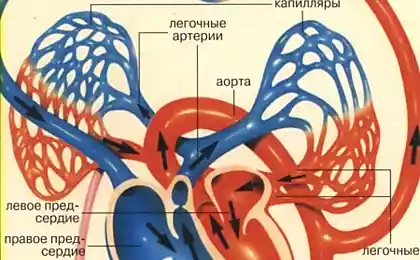431
What can we understand about a person at first sight: 11 scientific facts
It only took a few seconds as you saw the new man — whether on a date or in a queue store — and have you made a definite opinion about it, starting with how smart he is, to the offender or not.
Surprisingly, first impressions are often very accurate.
1. If the person is cute, then he probably still just a good

Social psychologists call it the halo effect: seeing an attractive person, we tend to believe that he has some positive qualities, such as intelligence or kindness. A psychologist from the University of Texas at Austin Daniel Hamermesh studying the attitude of the beautiful people in the workplace, in the course of his investigation found that the halo effect leads, among other things, to the fact that attractive people earn more.
In another study, male students were asked to evaluate the writing of unfamiliar students. In the case when students were shown a photo of an attractive young woman and said that she is the author, the work was deemed to be better than when students were shown a less attractive photo or didn't show anything.
2. The picture can give a fairly accurate assessment of human nature
Just looking at your photo, the vast majority of people will give you surprisingly accurate characteristics. Study participants, conducted in 2009, asked to evaluate 123 photographs of students of the University of Texas at Austin (students were asked to be photographed or with a neutral expression, or as they themselves want). The survey showed that, regardless of the type of photo, participants were very accurate in guessing the following characteristics of students: extroverted or introverted, high his self-esteem or low as it is religious, it is ready to compromise and how he is conscientious.
3. The tall man — the leader

In 2013, a group of psychologists, neuroscientists and experts in the field of computer Sciences from Europe and the United States asked respondents to look at photos 47 white males and 83 white women. On the basis of photographs, respondents were asked to decide how tall these people and how expressed their leadership skills. According to the study, respondents to draw conclusions about the height of a man based on sex and length of the face, and then, based on the same factors, decided the leader in front of them or not. People who were considered high, often ranked as leaders.
4. Wider cheekbones is more aggression
According to the results of a small study conducted at the Centre of behaviour change at University College London in 2013 and the higher the testosterone level in men, the wider their face and the more cheekbones. In men with similar features were also observed more pronounced tendency to aggression and suspicion.
5. Strong or good?
In the study by 2015, the respondents were shown pictures of 10 people with five different facial expressions. On the basis of photographs, respondents had to decide how these people are friendly and physically strong, and how they can be trusted.
It is not surprising that those people, whose faces in the photos looked happy, respondents seemed more friendly and trustworthy. People with broader features of the individuals interviewed believed stronger.
6. Suspiciously look like? Criminal!

It is difficult to explain why someone from the strangers we trust more, someone less, but the trust factor sometimes can play a decisive role.
A group of researchers from Israel and the UK asked study participants to look at photos of men and women, randomly selected from the two databases, and to determine the emotional state and the character of these people, and the likelihood that they face a criminal.
The first set of pictures were selected from the database of the police, the second is composed of photos of actors being asked to portray happy, angry or neutral facial expression.
The results showed: no matter the perpetrator in the picture or not, but if his face looks suspicious and overbearing, rather it deems such. In the photos of the second set of people with the most aggressive expression more readily considered criminals.
7. A matter of life and death
In 2015, two psychologists from the University of Toronto has collected photos of real prisoners who at the time was convicted of first-degree murder and were sentenced to prison terms Department of correctional services state of Florida. About half of them were serving life imprisonment; the other half was sentenced to death and awaited execution.
In the study, psychologists asked participants to look at photos and determine how much they trust these people on a scale from 1 (does not trust) to 8 (completely trust). The result often was that the prisoners whom the respondents trust the least, was in fact sentenced to death.
However, the study and the second part. In it, participants were asked to study photographs of people previously convicted of murder, but later acquitted, usually on the basis of DNA analysis. The alarming result: in this case, respondents felt less secure people's faces, which at first threatened with the death penalty, but who were subsequently acquitted.
"Judges can make a decision about the degree of criminal responsibility of a person based on his appearance regardless of his actual guilt," the researchers write in their paper.
8. What looks, for example, wrinkles, says about your health?
Wrinkles can give not only your age — they can also tell you about how is your heart. In 2012, researchers compared two groups of people: 261 people whose parents lived to a very old age, and arbitrary 253 men of the same age.
Scientists focused on the number of wrinkles on the face and forearms of these people and came to the following conclusion: women with a low risk of cardiovascular disease looked a few years younger than his real age unlike women with the highest risk of cardiovascular disease.
9. Other diseases can tell eyes

Just by looking you in the eye, doctors can determine the presence of a particular disease. Red spots on the retina and light-sensitive layer at the back of the eye can be a sign of diabetes. When the blood sugar gets too high, the blood vessels in the retina may be blocked, causing them to swell and burst.
10. However, only face is not enough. How to relate the length of a man's finger and cancer risk?
For 15 years, scientists have studied long-fingered 1.5 thousand patients with prostate cancer and 3 thousand healthy men. These men were asked to look at photos and choose the one that is most similar to their own.
Men who claim that their index finger was the same length or longer than their ring finger, the risk of prostate cancer was higher by one third than in men, the index finger which was shorter than the ring.
In the case when the respondents ' age was below 60 years, this pattern was observed even more clearly. Note, however, that the study was not based on actual measurements of finger length, but only on what men have said about themselves, and therefore likely to confirm the results, further research is needed.
Also interesting: How prayer changes blood
Video lectures: 7 lectures Tatyana Chernihiv on brain and language
11. And growth of the person also have to do with anything?
Studies show that tall people have a lower risk of cardiovascular disease, while people with less growth may have lower rates of cancer. It is assumed that this is directly related to the amount of growth hormone that can protect against certain diseases, but increases the risk of others.
The results of the study, however, reveal only a tendency and does not mean that human growth depends, ill he a particular disease or not.published
P. S. And remember, just changing your mind — together we change the world! ©
Source: ru.insider.pro/lifestyle/2016-08-03/11-nauchnykh-faktov-o-tom-chto-mozhno-poniat-o-cheloveke-s-pervogo-vzgliada/
Surprisingly, first impressions are often very accurate.
1. If the person is cute, then he probably still just a good

Social psychologists call it the halo effect: seeing an attractive person, we tend to believe that he has some positive qualities, such as intelligence or kindness. A psychologist from the University of Texas at Austin Daniel Hamermesh studying the attitude of the beautiful people in the workplace, in the course of his investigation found that the halo effect leads, among other things, to the fact that attractive people earn more.
In another study, male students were asked to evaluate the writing of unfamiliar students. In the case when students were shown a photo of an attractive young woman and said that she is the author, the work was deemed to be better than when students were shown a less attractive photo or didn't show anything.
2. The picture can give a fairly accurate assessment of human nature
Just looking at your photo, the vast majority of people will give you surprisingly accurate characteristics. Study participants, conducted in 2009, asked to evaluate 123 photographs of students of the University of Texas at Austin (students were asked to be photographed or with a neutral expression, or as they themselves want). The survey showed that, regardless of the type of photo, participants were very accurate in guessing the following characteristics of students: extroverted or introverted, high his self-esteem or low as it is religious, it is ready to compromise and how he is conscientious.
3. The tall man — the leader

In 2013, a group of psychologists, neuroscientists and experts in the field of computer Sciences from Europe and the United States asked respondents to look at photos 47 white males and 83 white women. On the basis of photographs, respondents were asked to decide how tall these people and how expressed their leadership skills. According to the study, respondents to draw conclusions about the height of a man based on sex and length of the face, and then, based on the same factors, decided the leader in front of them or not. People who were considered high, often ranked as leaders.
4. Wider cheekbones is more aggression
According to the results of a small study conducted at the Centre of behaviour change at University College London in 2013 and the higher the testosterone level in men, the wider their face and the more cheekbones. In men with similar features were also observed more pronounced tendency to aggression and suspicion.
5. Strong or good?
In the study by 2015, the respondents were shown pictures of 10 people with five different facial expressions. On the basis of photographs, respondents had to decide how these people are friendly and physically strong, and how they can be trusted.
It is not surprising that those people, whose faces in the photos looked happy, respondents seemed more friendly and trustworthy. People with broader features of the individuals interviewed believed stronger.
6. Suspiciously look like? Criminal!

It is difficult to explain why someone from the strangers we trust more, someone less, but the trust factor sometimes can play a decisive role.
A group of researchers from Israel and the UK asked study participants to look at photos of men and women, randomly selected from the two databases, and to determine the emotional state and the character of these people, and the likelihood that they face a criminal.
The first set of pictures were selected from the database of the police, the second is composed of photos of actors being asked to portray happy, angry or neutral facial expression.
The results showed: no matter the perpetrator in the picture or not, but if his face looks suspicious and overbearing, rather it deems such. In the photos of the second set of people with the most aggressive expression more readily considered criminals.
7. A matter of life and death
In 2015, two psychologists from the University of Toronto has collected photos of real prisoners who at the time was convicted of first-degree murder and were sentenced to prison terms Department of correctional services state of Florida. About half of them were serving life imprisonment; the other half was sentenced to death and awaited execution.
In the study, psychologists asked participants to look at photos and determine how much they trust these people on a scale from 1 (does not trust) to 8 (completely trust). The result often was that the prisoners whom the respondents trust the least, was in fact sentenced to death.
However, the study and the second part. In it, participants were asked to study photographs of people previously convicted of murder, but later acquitted, usually on the basis of DNA analysis. The alarming result: in this case, respondents felt less secure people's faces, which at first threatened with the death penalty, but who were subsequently acquitted.
"Judges can make a decision about the degree of criminal responsibility of a person based on his appearance regardless of his actual guilt," the researchers write in their paper.
8. What looks, for example, wrinkles, says about your health?
Wrinkles can give not only your age — they can also tell you about how is your heart. In 2012, researchers compared two groups of people: 261 people whose parents lived to a very old age, and arbitrary 253 men of the same age.
Scientists focused on the number of wrinkles on the face and forearms of these people and came to the following conclusion: women with a low risk of cardiovascular disease looked a few years younger than his real age unlike women with the highest risk of cardiovascular disease.
9. Other diseases can tell eyes

Just by looking you in the eye, doctors can determine the presence of a particular disease. Red spots on the retina and light-sensitive layer at the back of the eye can be a sign of diabetes. When the blood sugar gets too high, the blood vessels in the retina may be blocked, causing them to swell and burst.
10. However, only face is not enough. How to relate the length of a man's finger and cancer risk?
For 15 years, scientists have studied long-fingered 1.5 thousand patients with prostate cancer and 3 thousand healthy men. These men were asked to look at photos and choose the one that is most similar to their own.
Men who claim that their index finger was the same length or longer than their ring finger, the risk of prostate cancer was higher by one third than in men, the index finger which was shorter than the ring.
In the case when the respondents ' age was below 60 years, this pattern was observed even more clearly. Note, however, that the study was not based on actual measurements of finger length, but only on what men have said about themselves, and therefore likely to confirm the results, further research is needed.
Also interesting: How prayer changes blood
Video lectures: 7 lectures Tatyana Chernihiv on brain and language
11. And growth of the person also have to do with anything?
Studies show that tall people have a lower risk of cardiovascular disease, while people with less growth may have lower rates of cancer. It is assumed that this is directly related to the amount of growth hormone that can protect against certain diseases, but increases the risk of others.
The results of the study, however, reveal only a tendency and does not mean that human growth depends, ill he a particular disease or not.published
P. S. And remember, just changing your mind — together we change the world! ©
Source: ru.insider.pro/lifestyle/2016-08-03/11-nauchnykh-faktov-o-tom-chto-mozhno-poniat-o-cheloveke-s-pervogo-vzgliada/
LADA Connect will allow you to control the car using smartphone
Detroit Electric produced electric sedan and crossover
























